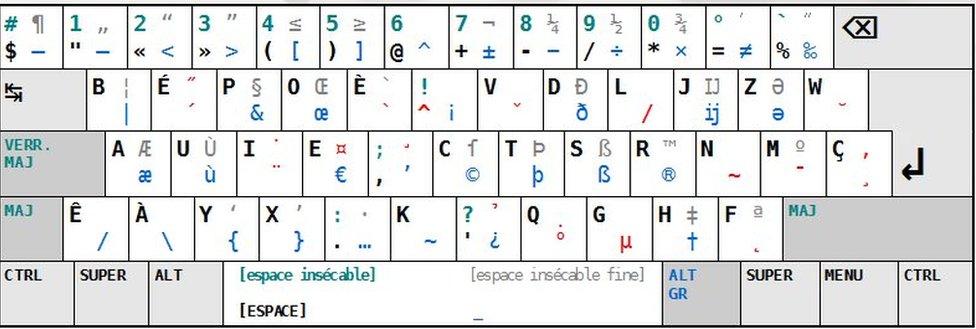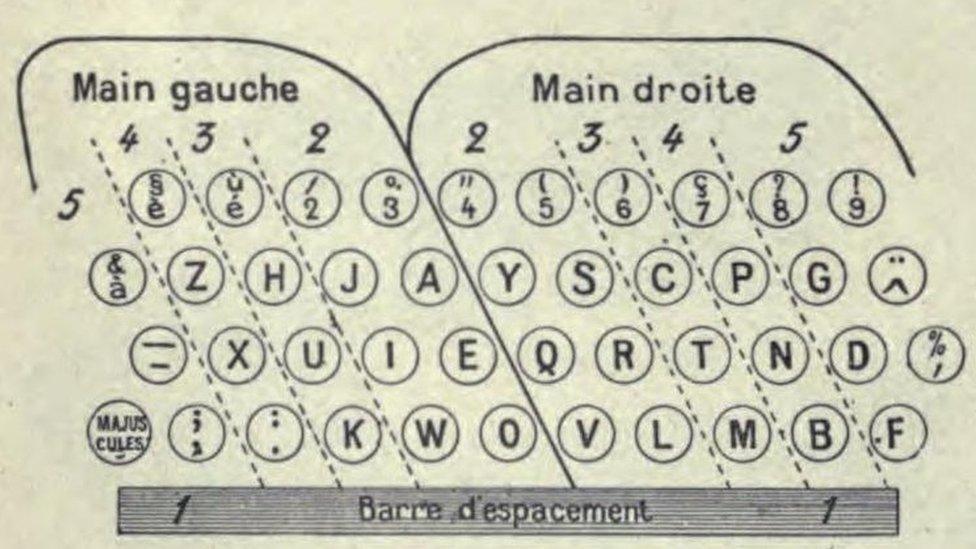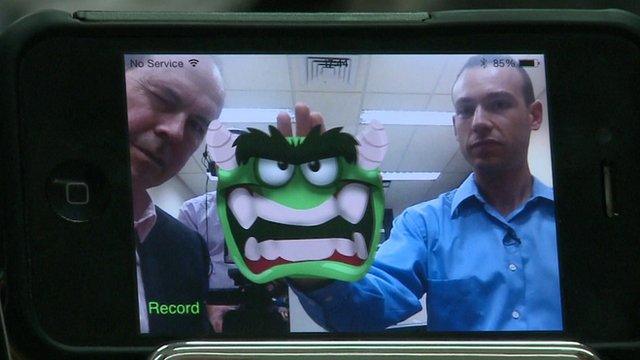Is France's unloved AZERTY keyboard heading for the scrapheap?
- Published
Hugh Schofield looks at the quirks of the AZERTY keyboard
France's 100 year-old AZERTY keyboard - the equivalent of the English-language QWERTY - is to be reconfigured after the government ruled that it encourages bad writing.
The AZERTY set-up has infuriated generations of writers, because of labour-creating peculiarities like the need for two strokes to make full-stops and numerals.
But official ire is directed less at such inconveniences, and more at certain quirks and oversights which, it says, make it hard to construct proper French.
"Today it is practically impossible to write French correctly using a keyboard that has been bought in France," the ministry intones.
"More surprisingly, certain European countries like Germany and Spain respect French writing better than the French are able to - because their keyboards permit it!"
The culture ministry has commissioned, external Paris-based consultancy AFNOR to draw up a list of recommendations by the summer.
The aim is to produce a new standard keyboard that will gradually replace the many varieties of AZERTY currently on the market.
What's wrong with AZERTY?

AZERTY was introduced as a French adaptation of the original QWERTY keyboard on US typewriters at the start of the 20th Century.
The main problem identified by the culture ministry is the difficulty for French writers to use "certain accented characters - and especially in upper-case".
Some common lower-case accented letters - like é (e-acute) and è (e-grave) - have dedicated keys on AZERTY.
The letter ù (u-grave) also has its own key, even though it is used in only one word in the entire French language - où, meaning where.
But other accented letters are harder to compose. And accented capital letters require manoeuvres of which, according to the ministry, most people are unaware.
This ignorance, and the consequent growing disuse of accented capitals, has given rise to the widespread belief that good French does not need them. Most people think that ignoring an accent on a capital letter is acceptable.
Not so! says the culture ministry, pointing out that both the Academie Francaise and the National Print have issued guidelines urging the use of accents on capitals.
A similar absence is that of a Ç - a capital C-cedilla, with the curly bit beneath signifying that it is pronounced like an 's'. Again the ministry says people think it is not necessary, but it is.
Likewise the two "ligatures" - æ and œ - the latter particularly common in words like œil (eye) and œuf (egg). Neither is accessible on the keyboard.
The ministry also laments the absence of what it says are the correct signs for introducing direct speech in French - the double chevrons « and », as opposed to the inverted commas used in English.
And it wants to make it easier to write in regional French languages, like Occitan, Catalan, Breton and Polynesian.
So symbols like the tilde (the squiggle on a ñ), the interpunct (mid-line dot, used in Catalan), and the macron (bar above a vowel - ā -indicating length) all need to be readily available.
Ergonomically disastrous

Some enthusiasts are backing the BEPO keyboard, which is based on a statistical study of French
"The idea is not to impose anything, but simply to make it possible for people to obey the rules," says Philippe Magnabosco, who is running the project at AFNOR.
"Right now, there is a big discrepancy between French grammar and the possibilities offered by the keyboard."
One thing the recommendations are unlikely to change is the AZERTY configuration itself - this despite the fact that most agree it is ergonomically disastrous.
No-one knows who first devised AZERTY, but it took hold in the last decade of the 19th Century. It is a lightly modified version of the QWERTY keyboard which was patented in the US 20 years earlier.

More than a century ago, there were calls for a ZHJAY keyboard to be introduced
Over the years different analysts have pointed out that the lay-out makes little sense for French. The home-row (or middle letter-bar - the most accessible) contains too many uncommon letters; and the left hand is over-used.
Plus there is the nonsense of having to go into upper-case mode to write full-stops and numbers.
As early as 1907 an alternative arrangement was proposed (ZHJAY).
Today some enthusiasts are pushing for another (BEPO).
But writing habits are by now too deeply ingrained.
Some changes are coming, but A-Z-E-R-T-Y is most likely here to stay.
- Published5 November 2015

- Published12 February 2014

- Published11 August 2010